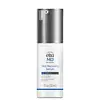What's inside
What's inside
 Key Ingredients
Key Ingredients

 Benefits
Benefits

 Concerns
Concerns

 Ingredients Side-by-side
Ingredients Side-by-side

Water
Skin ConditioningButylene Glycol
HumectantGlycerin
HumectantPanthenol
Skin Conditioning1,2-Hexanediol
Skin ConditioningHydroxyacetophenone
AntioxidantCollagen
MoisturisingHydroxyethylcellulose
Emulsion StabilisingAllantoin
Skin ConditioningSodium Hyaluronate
HumectantPropanediol
SolventBakuchiol
AntimicrobialPolysorbate 20
EmulsifyingCentella Asiatica Extract
CleansingCaprylyl Glycol
EmollientCamellia Sinensis Extract
AntioxidantPropylene Glycol
HumectantEthylhexylglycerin
Skin ConditioningCaprylic/Capric Triglyceride
MaskingPhospholipids
Skin ConditioningPotassium Sorbate
PreservativeSodium Benzoate
MaskingAstaxanthin
Skin ConditioningArginine/Lysine Polypeptide
Skin ConditioningPalmitoyl Tripeptide-1
Skin ConditioningWater, Butylene Glycol, Glycerin, Panthenol, 1,2-Hexanediol, Hydroxyacetophenone, Collagen, Hydroxyethylcellulose, Allantoin, Sodium Hyaluronate, Propanediol, Bakuchiol, Polysorbate 20, Centella Asiatica Extract, Caprylyl Glycol, Camellia Sinensis Extract, Propylene Glycol, Ethylhexylglycerin, Caprylic/Capric Triglyceride, Phospholipids, Potassium Sorbate, Sodium Benzoate, Astaxanthin, Arginine/Lysine Polypeptide, Palmitoyl Tripeptide-1
Water
Skin ConditioningPropanediol
SolventIsododecane
EmollientGlycerin
HumectantDimethicone
EmollientPolymethylsilsesquioxane
Polysilicone-11
Panthenol
Skin ConditioningCoco-Caprylate/Caprate
EmollientTaurine
BufferingSodium Acrylate/Sodium Acryloyldimethyl Taurate Copolymer
Emulsion StabilisingArginine
MaskingButylene Glycol
HumectantTocopherol
AntioxidantHydroxyacetophenone
AntioxidantIsohexadecane
EmollientCentella Asiatica Leaf Extract
Skin ConditioningAmmonium Acryloyldimethyltaurate/Carboxyethyl Acrylate Crosspolymer
Caprylyl Glycol
Emollient1,2-Hexanediol
Skin ConditioningCoco-Glucoside
CleansingPolysorbate 80
EmulsifyingDecyl Glucoside
CleansingHydroxyethylcellulose
Emulsion StabilisingCitric Acid
BufferingTrisodium Ethylenediamine Disuccinate
Glycine
BufferingSodium Hyaluronate
HumectantWater, Propanediol, Isododecane, Glycerin, Dimethicone, Polymethylsilsesquioxane, Polysilicone-11, Panthenol, Coco-Caprylate/Caprate, Taurine, Sodium Acrylate/Sodium Acryloyldimethyl Taurate Copolymer, Arginine, Butylene Glycol, Tocopherol, Hydroxyacetophenone, Isohexadecane, Centella Asiatica Leaf Extract, Ammonium Acryloyldimethyltaurate/Carboxyethyl Acrylate Crosspolymer, Caprylyl Glycol, 1,2-Hexanediol, Coco-Glucoside, Polysorbate 80, Decyl Glucoside, Hydroxyethylcellulose, Citric Acid, Trisodium Ethylenediamine Disuccinate, Glycine, Sodium Hyaluronate
Ingredients Explained
These ingredients are found in both products.
Ingredients higher up in an ingredient list are typically present in a larger amount.
1,2-Hexanediol is a synthetic liquid and another multi-functional powerhouse.
It is a:
- Humectant, drawing moisture into the skin
- Emollient, helping to soften skin
- Solvent, dispersing and stabilizing formulas
- Preservative booster, enhancing the antimicrobial activity of other preservatives
Butylene Glycol (or BG) is used within cosmetic products for a few different reasons:
Overall, Butylene Glycol is a safe and well-rounded ingredient that works well with other ingredients.
Though this ingredient works well with most skin types, some people with sensitive skin may experience a reaction such as allergic rashes, closed comedones, or itchiness.
Learn more about Butylene GlycolCaprylyl Glycol is a humectant and emollient, meaning it attracts and preserves moisture.
It is a common ingredient in many products, especially those designed to hydrate skin. The primary benefits are retaining moisture, skin softening, and promoting a healthy skin barrier.
Though Caprylyl Glycol is an alcohol derived from fatty acids, it is not the kind that can dry out skin.
This ingredient is also used as a preservative to extend the life of products. It has slight antimicrobial properties.
Learn more about Caprylyl GlycolGlycerin is already naturally found in your skin. It helps moisturize and protect your skin.
A study from 2016 found glycerin to be more effective as a humectant than AHAs and hyaluronic acid.
As a humectant, it helps the skin stay hydrated by pulling moisture to your skin. The low molecular weight of glycerin allows it to pull moisture into the deeper layers of your skin.
Hydrated skin improves your skin barrier; Your skin barrier helps protect against irritants and bacteria.
Glycerin has also been found to have antimicrobial and antiviral properties. Due to these properties, glycerin is often used in wound and burn treatments.
In cosmetics, glycerin is usually derived from plants such as soybean or palm. However, it can also be sourced from animals, such as tallow or animal fat.
This ingredient is organic, colorless, odorless, and non-toxic.
Glycerin is the name for this ingredient in American English. British English uses Glycerol/Glycerine.
Learn more about GlycerinHydroxyacetophenone is antioxidant with skin conditioning and soothing properties. It also boosts the efficiency of preservatives.
This ingredient is not irritating or sensitizing.
Hydroxyethylcellulose is used to improve the texture of products. It is created from a chemical reaction involving ethylene oxide and alkali-cellulose. Cellulose is a sugar found in plant cell walls and help give plants structure.
This ingredient helps stabilize products by preventing ingredients from separating. It can also help thicken the texture of a product.
This ingredient can also be found in pill medicines to help our bodies digest other ingredients.
Learn more about HydroxyethylcellulosePanthenol is a common ingredient that helps hydrate and soothe the skin. It is found naturally in our skin and hair.
There are two forms of panthenol: D and L.
D-panthenol is also known as dexpanthenol. Most cosmetics use dexpanthenol or a mixture of D and L-panthenol.
Panthenol is famous due to its ability to go deeper into the skin's layers. Using this ingredient has numerous pros (and no cons):
Like hyaluronic acid, panthenol is a humectant. Humectants are able to bind and hold large amounts of water to keep skin hydrated.
This ingredient works well for wound healing. It works by increasing tissue in the wound and helps close open wounds.
Once oxidized, panthenol converts to pantothenic acid. Panthothenic acid is found in all living cells.
This ingredient is also referred to as pro-vitamin B5.
Learn more about PanthenolPropanediol is an all-star ingredient. It softens, hydrates, and smooths the skin.
It’s often used to:
Propanediol is not likely to cause sensitivity and considered safe to use. It is derived from corn or petroleum with a clear color and no scent.
Learn more about PropanediolSodium Hyaluronate is hyaluronic acid's salt form. It is commonly derived from the sodium salt of hyaluronic acid.
Like hyaluronic acid, it is great at holding water and acts as a humectant. This makes it a great skin hydrating ingredient.
Sodium Hyaluronate is naturally occurring in our bodies and is mostly found in eye fluid and joints.
These are some other common types of Hyaluronic Acid:
Learn more about Sodium HyaluronateWater. It's the most common cosmetic ingredient of all. You'll usually see it at the top of ingredient lists, meaning that it makes up the largest part of the product.
So why is it so popular? Water most often acts as a solvent - this means that it helps dissolve other ingredients into the formulation.
You'll also recognize water as that liquid we all need to stay alive. If you see this, drink a glass of water. Stay hydrated!
Learn more about Water